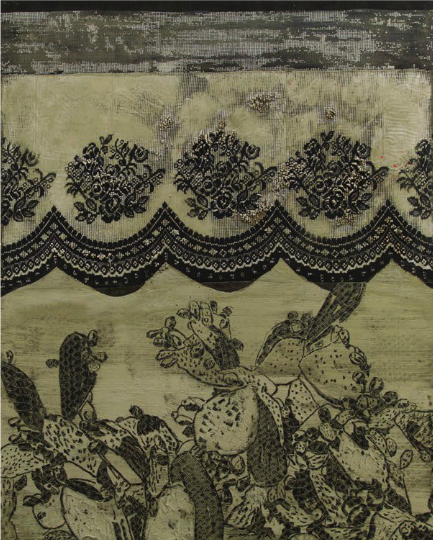House Without Home at Goucher College’s Silber Art Gallery by Anna Fine Foer
The opening reception and artist’s talk for Naomi Safran-Hon’s exhibition was held on a dark, rainy evening. While driving through the dense fog on my way to the gallery, I became increasingly aware of the contrast between my present surroundings and that of the typical Israeli environment. It was this sun-drenched, dry, and dusty environment featured in the artist’s work at Goucher’s Silber Gallery. The images in the exhibit and artist’s talk reinforced that dichotomy.

House Without Home could be about any home and lives, anywhere that people are displaced – either by a natural disaster or by a man-made tragedy. However, Safran-Hon was determined, when studying art in the US, to make work about Israel, her homeland.
Safran-Hon was profoundly influenced by newspaper photos of destruction caused by the war in Lebanon during the summer of 2006. She used these photos as subjects for paintings. Soon after, when she visited Wadi Salib, the Haifa neighbourhood where she grew up, she photographed the decaying homes there. These photos were collaged onto canvas. Layers of painting and drawing were applied to the photos until they became no longer about war and destruction, but rather about daily life in a war zone and the effect of neglect when a home is abandoned.
 The artist began to experiment with cement as soon as she started graduate work at Yale. At first, she simply applied cement to photos, the cement placed on top of the photographic depiction of a wall, for example. Then, she progressed to squeezing cement through lace which conjured up images of feminine, domestic, interior spaces; lace curtains and lace patterns on window guards.
The artist began to experiment with cement as soon as she started graduate work at Yale. At first, she simply applied cement to photos, the cement placed on top of the photographic depiction of a wall, for example. Then, she progressed to squeezing cement through lace which conjured up images of feminine, domestic, interior spaces; lace curtains and lace patterns on window guards.
Eventually, she started to push cement through holes gouged in her collaged paintings. The gouges are then mapped by tracing them onto drawing paper that becomes an inverse of the multi-layered, collaged canvases. These are a stripped down, minimalist depiction of an interior space, devoid of surface texture and colour. They have a dimensionality all their own. Now black and white is the only reference to the interior/exterior duality. The holes could also be voids made by shrapnel or bullets.


Many readers may not understand why there are abandoned homes in the middle of a thriving Israeli city in 2007 or even today in 2016. One is reminded of all the vacants in Baltimore and the politics surrounding their vacancy. These homes in Wadi Salib have been uninhabited since the Israeli War of Independence in 1948 and their disputed ownership reflects the complexity of the political climate in Israel.
In House Without Home, Naomi Safran-Hon investigates seemingly disparate elements in a tactile, abstract way: creating surface patterns and textures that have been removed from the context of a home. Whether the view is interior or exterior and whether the abandoned home is in a hurricane zone or a sun-drenched, arid desert, the question is the same. The artist is asking what makes a house a home in the first place, challenging viewers to come up with their own answer to that question.







 From the opening reception at Silber Gallery
From the opening reception at Silber Gallery
<><><><><><><><>
Author Anna Fine Foer is an Annapolis-based visual artist. View her work at annafineart.com.
Photos by Anna Fine Foer and courtesy of Goucher College.
This exhibition is in conjunction with a larger, group show of contemporary Israeli art: “Visions of Place” at Towson University’s Center for the Arts.
See the show at Goucher University’s Silber Gallery now through April 3rd.
Naomi Safran-Hon grew up in Haifa, Israel but currently resides in Brooklyn, NY. In this body of work Safran-Hon investigates her relationship to Israel and its on-going conflict, revealing the fragility of the human experience. This is her first solo show in the Baltimore area. House Without Home brings together 13 pieces that depict fragments of a house but don’t create a home. Safran-Hon’s paintings combine, fabric, cement, and pigment, acrylic and photograph to tell the stories of these structures and their former inhabitants. Co-curators: Laura Amussen, Exhibitions Director and Curator, Goucher College, Silber and Rosenberg Art Galleries and J. Susan Isaacs, Professor of Art History and Curator of the Holtzman MFA and Center for the Arts Galleries, Towson University.






